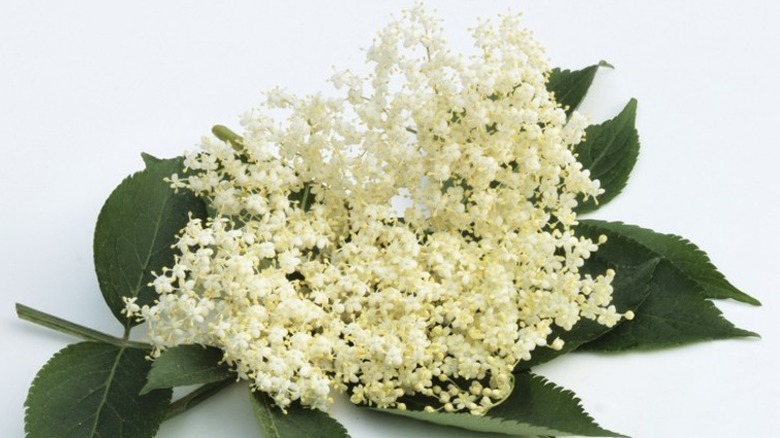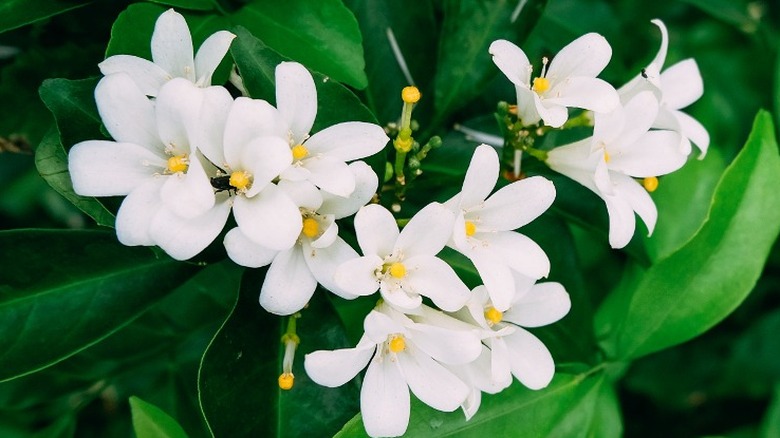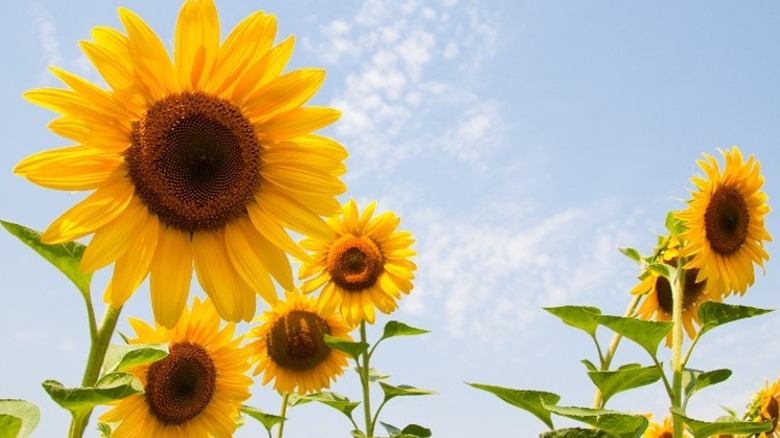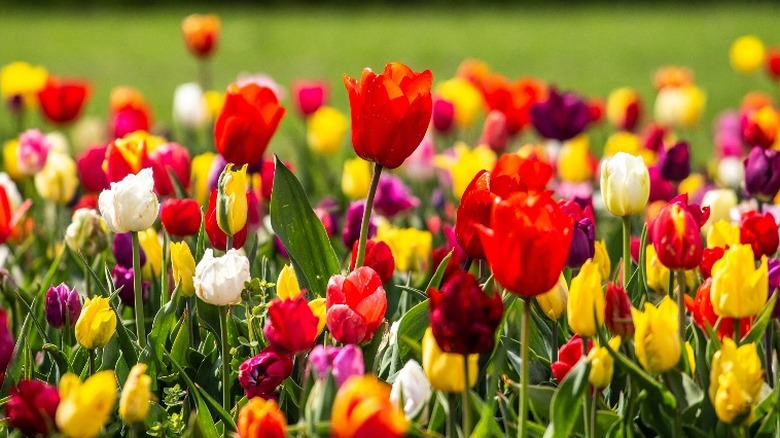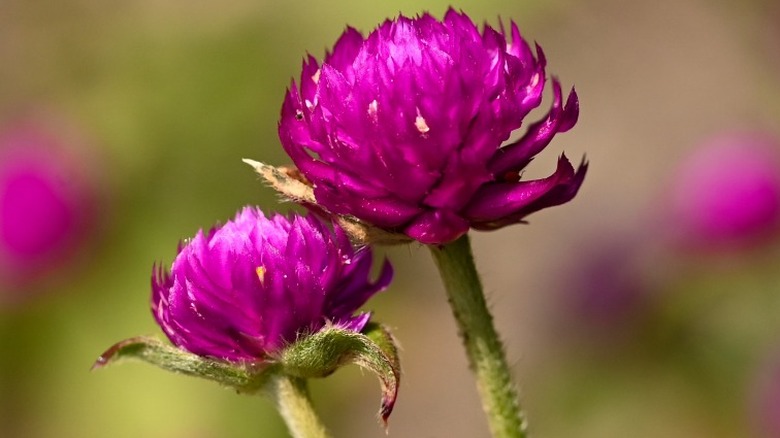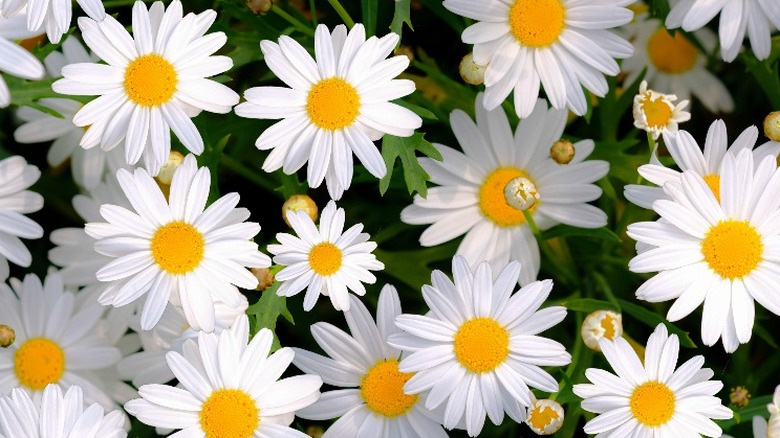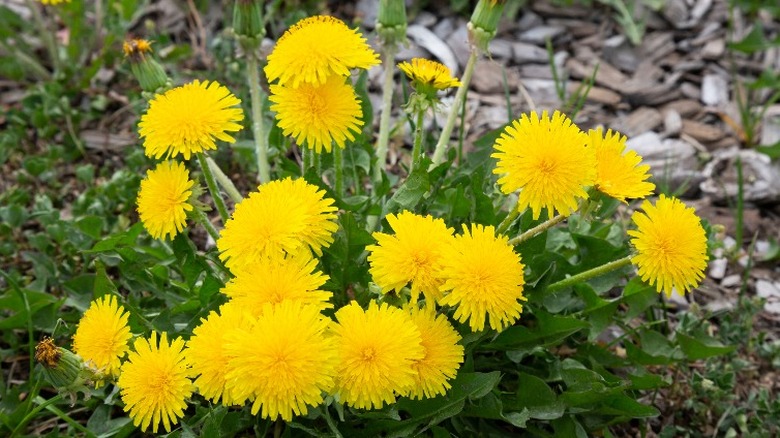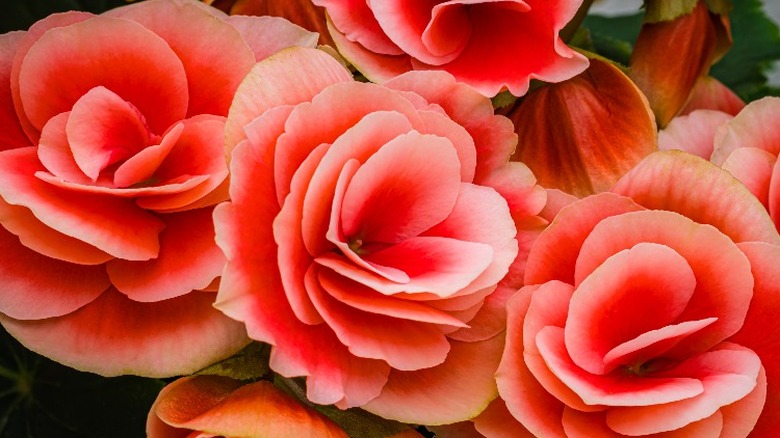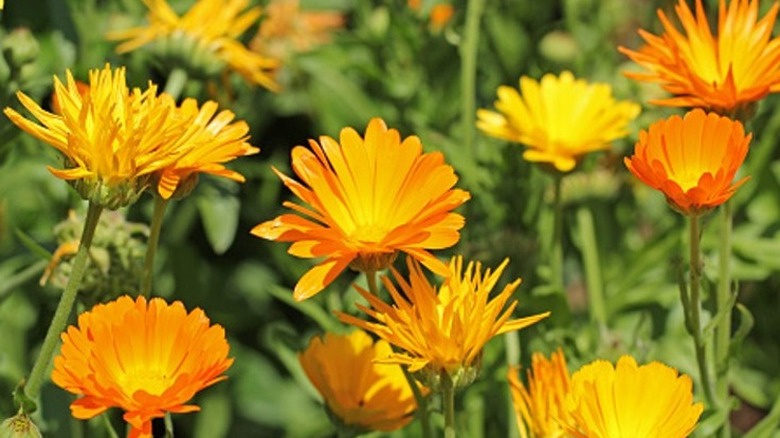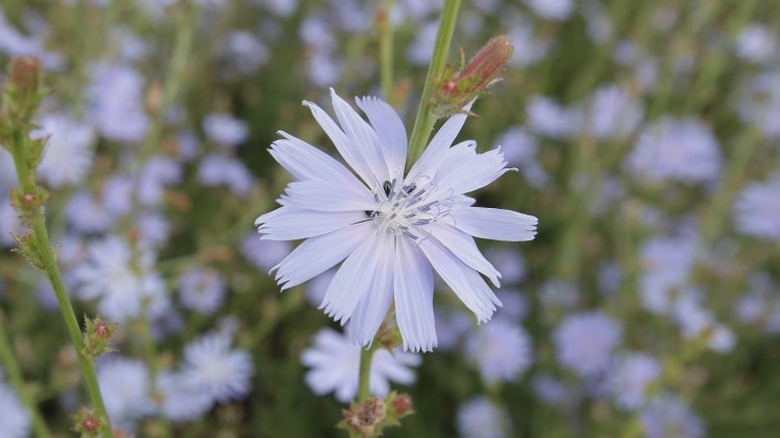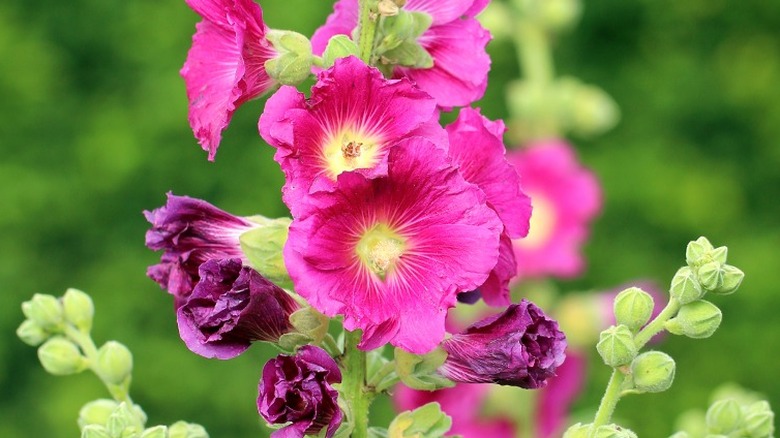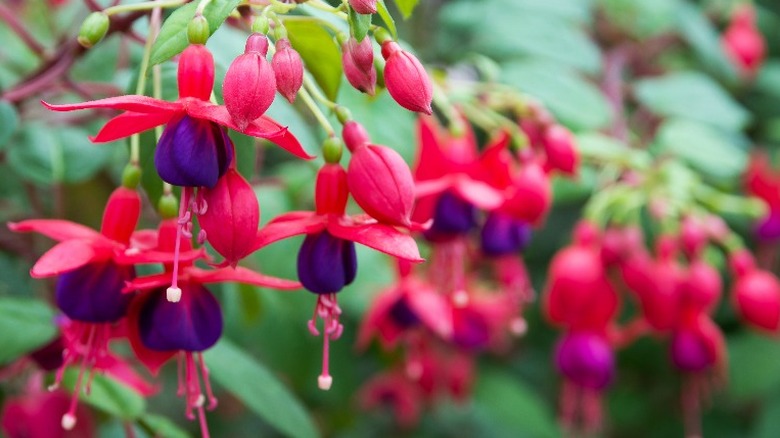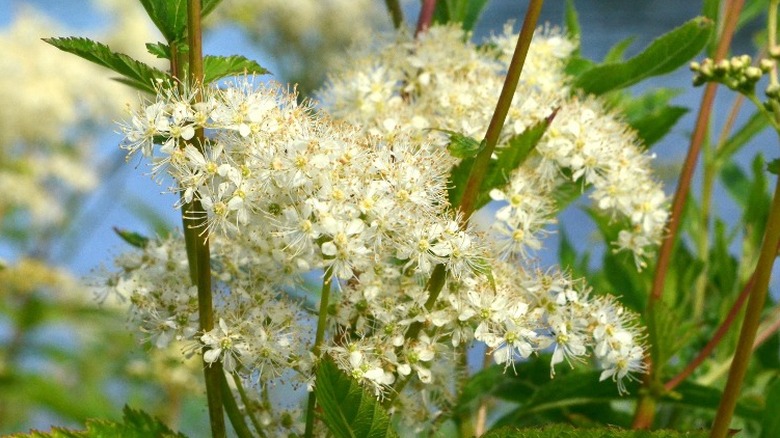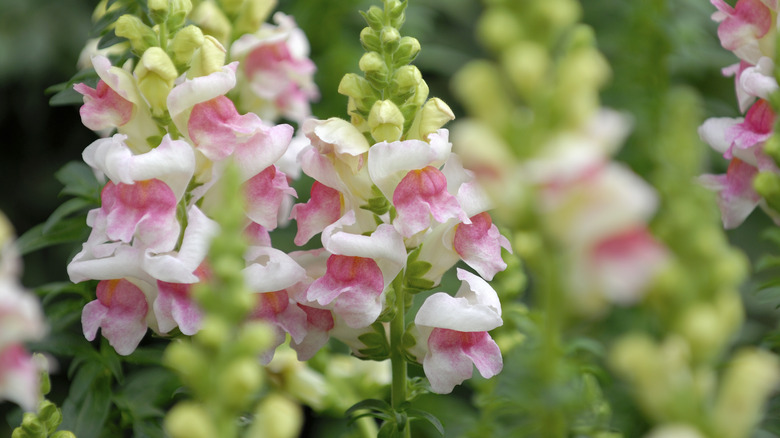15 Worst Tasting Edible Flowers
Flowers are endlessly inspiring. Throughout history, painters have recreated their beauty with brushstrokes, and poets have attached symbolic meanings. Something about eating these "stars of the earth," as Clara Lucas Balfour once called them, feels romantic. In Gabriel Garcia Marquez's 1988 novel "Love in the Time of Cholera," the character Florentino becomes so obsessively in love with a woman that he takes to eating the gardenias from her backyard to feel closer to her. But long before humans were eating flowers for the romantic novelty of it, they were ingesting them for medicinal reasons.
Edible flowers have a history that dates back to ancient times in regions worldwide. The Ancient Greeks, Romans, and Chinese were certainly cognizant of their benefits, and today, you'll frequently find floral flavors in Middle Eastern and French cuisine. Roses, orange blossoms, hibiscus, and lavender are some of the most popular. While eating flowers, in general, isn't everyone's cup of tea, there's no denying that edible flowers are growing in popularity not only for their delicate flavors but also for the botanical beauty they add to plates. Some flowers that end up on the dinner table might be best left in the garden, but ultimately, it's all about personal tastes.
Elderflowers
You might be surprised to find elderflowers on this list, considering that throughout history, the bloom of the elder tree has been used to make delicious floral concoctions. But here's the deal: in its purest form, raw elderflower isn't as tasty as you might imagine. The flavor can be cutting and teraceous, and when uncooked, they're actually mildly toxic. Worse yet, the smell of fresh elderflowers has been compared to the scent of cat urine. It's one of the reasons that traditionally, elderflower has been infused in a tisane or used to make syrups and cordials. Cooking rids the lovely flowers of their toxic taste, and a more delicate flavor and sweeter scent emerge.
Though eating the flowers right off the stem won't kill you, it could result in an upset stomach. However, once infused, the flavor of the delicate petals can be effectively used for elderflower vinegar or champagne, syrups, and elderflower liqueur like St-Germain. The flowers can also be cooked into elderflower fritters. Even if you still don't like the taste after they're cooked, it's worth noting that elderflowers have medicinal qualities that could be beneficial. Elderflowers have anti-inflammatory properties and contain vitamins A and B.
Jasmine flowers
Few things are more delicately aromatic than a perfumed cup of jasmine-scented tea. But scented is the focus word. While jasmine flowers are edible, they're rarely eaten. Jasmine tea dates back to the Ming Dynasty in China. The production of the tea is a precise process that transfers the scent of the jasmine flowers to the tea leaves. The final product does not traditionally contain the actual blossoms. The Encyclopedia of Herbs and Herbalism notes that jasmine's primary use is "for fragrant enjoyment." If you were to eat the flowers, you would find their intense fragrance makes them extremely bitter.
Not surprisingly, jasmine is often used in perfumes, with regard to the alluring botanical notes also having an underlying camphoraceous layer and punchy flavor. So while the taste is too intense to truly be enjoyable, jasmine flowers can make a lovely and floral-smelling garnish to enhance sensory experiences, especially with sweet treats or dishes containing jasmine rice (which doesn't contain jasmine but named after the flower due to its similar color and aromatic fragrance).
Sunflowers
Sunflowers are native to America and have been used by humans for centuries. The entire plant is edible. The seeds are the most popular part to chow down on, and the oil is also a prevalent product made from the flower, but people have also taken to eating the petals, the shoots, and the tubers are known as "sunchokes" or "Jerusalem artichokes" that grow in certain sunflower varieties. It's even possible to boil the buds and eat them like artichokes and believe it or not, the large, tough center can be grilled whole. But the real question is: does it taste good?
Answers vary, but on the whole, the consensus seems to be that eating the center of the flower is a fibrous, chewy experience that doesn't possess a lot of palatability. The petals can also be quite biting even when brewing into a tisane, though adding honey to a warm cup of sunflower tea can be an enjoyable way to take advantage of the flower's anti-inflammatory properties and bittersweet notes.
Tulips
Although they are often used to brighten and beautify dishes, edible flowers aren't only associated with aesthetic or romantic experiences. There have been times when eating flowers was born out of desperation. During World War II, The Netherlands experienced a famine, and eating tulip bulbs became common. While The Netherlands' vast tulip fields provided sustenance during this time, eating them wasn't a pleasant experience.
A Dutch housewife in 1944 wrote, "The boys now have to go far into the fields to pull frozen tulip bulbs from the ground. We grind the pulp and make thin soup and water porridge from them. They are bitter, practically inedible, but we choke them down because otherwise, we will starve," per "Edible Flowers: A Global History." Movie star Audrey Hepburn survived on tulip bulbs as a young girl in Holland during the German occupation.
While some chefs experiment with onion-like bulbs in dishes, they can be mildly toxic, especially if the bulb's core is not removed. But even handling the bulbs can cause a condition known as "tulip fingers," an allergic reaction triggered by the chemical tuliposide A (via the National Library of Medicine). All in all, tulips are probably best admired for their colors than their flavors.
Globe amaranths
The amaranth plant has been used in culinary preparations for thousands of years. On some varieties, seeds are considered an ancient grain that the Aztecs used to make dough and are now used as gluten-free substitutes. The globe amaranth, which blooms with hot pink or purple flowers, is used to make brightly colored herbal tea. In traditional Chinese medicine, the flower is called qian ri hong, which translates to "a thousand days red," and is often used to treat coughs, according to Wu Feng Tea. Many properties are shared between the seed and flower, and as such, it is also allegedly high in antioxidants.
While the flavor of this tisane, which has been compared to beetroot or sweet mushroom, might be appealing to some, the spiky texture of the flowers renders them unpleasant to eat on their own. That being said, the little pom-pom buds would certainly make a cute garnish on desserts.
Daisies
Like a weed, daisies grow just about everywhere in the world. These small humble white and yellow flowers can be found on every continent except Antarctica. We may know them as the flowers children pick and make daisy chains with, but traditionally daisies were used for medicinal purposes. They were especially useful in creating poultices and ointments for treating wounds and bruises, according to Plants for a Future.
The daisy is arguably the cutest of all the edible flowers on this list. So much so that it's hard to imagine them not tasting like sugary, fluffy little candies. Instead, the flavor of daisies could be described as sour, loamy with mustard notes, and like many other flowers on this list, a bit bitter. For this reason, you're better off using this ingredient as an adorably bright garnish tossed to the side of the plate instead of a legitimate ingredient.
Dandelions
Dandelions are closely related to daisies, and the similarities are visually apparent. A very common flower, dandelions can be traced back to Ancient Greece, and in mythology, Theseus was said to have eaten dandelions for 30 days before fighting the Minotaur. The small yellow flower has had a variety of medicinal and culinary uses throughout history.
While the young buds have a sweeter flavor, once the flower comes to full bloom, it's biting. In fact, dandelion is thought to be one of the bitter herbs used during the first Passover. Because of its acrid nature, flowers, greens, and roots have often been used to make digestifs. Dandelion wine, for instance, has a long history of being consumed as an aid for digestion.
If you can get past its sharp flavor, then there are many benefits to gain from consuming this flowering weed. It's considered a superfood and is loaded with vitamins and antioxidants, per Healthline. The ground root of the dandelion flower can also be mixed with water and used as a healthy coffee alternative.
Begonias
There are commonly only two types of edible begonias. The first is the tuberous begonia which is said to have a sour taste that may be reminiscent of a citrus flavor but can be off-putting to some. Many flower professionals suggest reserving them for use as a pretty garnish due to their acerbity. Individuals who do decide to nibble on this type of begonia must be careful.
Per Medical News Today, this plant's flowers and stem contain oxalic acid, an organic compound that exists in many plants, including ones frequently eaten like kale and spinach. However, in high quantities, this acid can cause kidney stones. Thus, these flowers should be eaten in moderation and avoided altogether by those prone to kidney stones, gout, or suffering from rheumatism, per "Edible Flowers: A Global History."
The other edible variety is the wax begonia. These also don't have a very pleasant taste, which has been described as astringent and marshy.
Calendulas
Ancient Romans ate calendula to induce sleepiness and believed ingesting the flower could allow one to see fairies. Later in history, this golden edible flower, sometimes called pot marigold, was used to color cheeses and butter. Today, you'll probably be most familiar with calendula as an herb used topically in creams that help ease skin irritations.
Both the petals and the leaves are edible, but one should beware: they're not the best-tasting flowers you can get your hands on. Though they certainly make aesthetically pleasing garnishes, they must be used sparingly to not overwhelm dishes with their acrid taste. Dr. Weil, the celebrity doctor and mastermind behind True Food Kitchen, once published an article exploring just how bad calendula tastes, noting how bitter it is and even hyperbolically calling it a "post-apocalyptic garnish for the cans of dog food." Calendula is best described as an edible flower with more medicinal value than culinary importance.
Chicory flowers
If you've heard of chicory coffee, you're probably familiar with the root famously used as a java substitute or as a roasty, chocolatey addition to ground coffee. The famous Café Du Monde in New Orleans, for example, mixes chicory root with its coffee. But long before people were sipping cups of this brewed root with beignets in the French Quarter, Ancient Egyptians incorporated chicory into their diet, not only using the root, but taking advantage of the medicinal properties of the flower and leaves as well. The flower that blooms from chicory is a lovely blue color but, unfortunately, tastes remarkably mordant.
If you can get past its acrimonious flavor, however, chicory flowers have traditionally been used for various reasons. According to The National Library of Medicine, the ailments it has been a treatment for sinus problems, diarrhea, gallstones, and gastroenteritis. To top it off, chicory was once considered to be an effective hangover cure.
Hollyhocks
Closely related to the tangy and tart hibiscus flower, hollyhocks are native to China and grow in a variety of colors, from pink to black. Although hollyhocks are edible, they have a reputation for being much less tasty than their tropical cousin. The flavor isn't necessarily revolting; it's more like nearly nonexistent. The extreme blandness can be off-putting, and when eaten on their own hollyhocks, the dull taste and unpleasant texture make for a less-than-palatable experience.
Luckily, this very same blandness makes hollyhocks a great addition to tisanes flavored with stronger herbs. This is the best way to unlock the many medicinal properties of this versatile plant. The flowers are known for being demulcent and emollient, meaning it soothes inflammation and irritation. Thus, in an herbal infusion, hollyhocks can be soothing for sufferers of sore throats. The black variety of this flower can also be used as a dye, with the final result being dark blue-purple.
Fuchsias
The bright pink-purple color takes its name from these flowers that are native to Central and South America as well as New Zealand and Tahiti. The bell-shaped blooms are part of the evening primrose family, and every part of the plant is non-toxic and edible, including berries. While the berries range in flavor, tasting citrine or peppery, the flowers have an acidic, sour, grassy, or acerbic taste that isn't the most appealing flavor.
That being said, despite their acrid flavor, the flowers contain compounds called anthocyanins which are naturally occurring dyes responsible for the bright hues of the petals. Scientific studies show that anthocyanins contain anti-inflammatory properties and antioxidants that could potentially be used to treat conditions that cause chronic inflammation. And, of course, even if you don't plan to ingest the flowers, fuchsias make an eye-catching decoration for celebration cakes or as a tropical garnish to liven a dish.
Buzz buttons
Buzz buttons defy any expectation you may have about what edible flowers should taste like. Eating these flowers can be more like eating a snack from an alien planet than munching on something Mother Nature created. While their flavor is tart and a bit acidic in an herbal way, these flowers are used more for the sensory experience they provide. Also known as Szechuan buttons (after the pepper that has a similar effect), electric buttons, or electric daisies, these unusual button-shaped buds contain spilanthol, an alkaloid that causes a tingling sensation, per Saveur. For this reason, they were once used medicinally to numb the mouth and treat toothaches and sore throats.
Ingesting a buzz button can feel like getting an electric shock to the mouth, like eating pop rocks but without the candy sweetness. Chefs have taken to occasionally incorporating this edible flower into dishes for the thrill of the sensation, but beyond the novelty of the jolt, buzz buttons don't have much to offer flavor-wise, and the numbing sensation can even be anxiety-inducing for some.
Meadowsweet
With a name like meadowsweet, you'd think this flowering herb would have a pleasant taste. While it's true that the flowers can smell sweet, their taste is not. The flavor is often described as very medicinal, which for some can mean metallic, detergent-like, or acerbic. This makes sense, considering it's a plant traditionally ingested for medical rather than culinary reasons. According to Healthline, it contains salicylates and tannins, compounds that contain anti-inflammatory properties. Historically meadowsweet has been used to treat conditions like gout, arthritis, and joint pain, as well as heartburn and stomach ulcers.
For medicinal uses, the flowers were infused into hot water to create a potable tisane. It's important to note that research is limited in its actual effectiveness. Meadowsweet likes damp areas, so can frequently be found around swamps and marshes. There's a profusion of these wildflowers in Ireland and England, as well as in certain parts of America. The flowers may not taste great, but the fairy-like fluffiness of the blooms are lovely to look at.
Snapdragons
Snapdragons get their name from their unusual shape resembling those mythical reptilian creatures of yore. When you squeeze the blossoms, the petals open and close as if they were the mouth of a dragon opening wide to breathe fire. Due to their whimsical charm, it's easy to see why snapdragons would be a popular floral decoration. They're certainly edible, but the texture is unpleasant, and the flavor leaves something to be desired.
The taste of snapdragons has been described anywhere from dull to biting and is one of those edible flowers that may not appeal to many palates. Just how pungent the unpleasant flavor largely depends on the soil and growing conditions. However, their brilliant colors and fun shape make for a great garnish. As with all flowers you plan to consume, always ensure they have been grown to be food safe to avoid ingesting harmful pesticides and chemicals.

